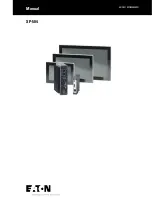
I.L. 3778A20B
Page 2
Effective 11/97
This device is longer than the standard VCP-W breaker.
Therefore:
1. Electrical Ground and Test Device must be
handled with extreme care while loading it on or
removing it from the extension rails.
2. The extension rails cannot be engaged or disen-
gaged with the device in the “Test” position -
the device must be either removed or in the
“Connected” position.
3. The device cannot be stored in a Vac Clad-W
breaker compartment. It can only be stored in a
storage compartment.
The stored energy closing mechanism for the power
grounding switch is the same as used in type VCP-W
breakers. It is capable of applying the ground against a
“live” circuit if operational errors have not cleared the cir-
cuit. However, in such a case, the relaying at the
source of power is expected to cause the source inter-
rupter to clear the circuit
as this device has no inter-
rupting capability.
1-2.1 POWER GROUNDING SWITCH OPERATION
Closing
The power grounding switch is closed by a control
switch at the end of a 35 ft. long cable (supplied
with the device). The control switch is a spring-
return type to the neutral (unlabeled) position.
Upon turning the control switch to “Close” position
(note that the control switch does not have to be
held in the “Close” position):
1. The closing springs start to charge
2.
After the springs are fully charged, they
automatically discharge to close the switch
contacts.
The control scheme (Figure
6
) has an interlock
contact KT that prevents the ground switch from
closing when the selector switch is locked in the
“Lower Terminals” position by key interlock KT1 in
Figure
2
. Once the ground switch is closed, it can
be locked in the closed position by removing the
cable from the receptacle on the device and locking
the sliding cover that permits access to the
receptacle and manual “Push to Open” button.
Opening
The grounding switch can be opened by manual
operation of the “Push to Open” button located
behind the sliding cover on the device front panel,
Figure
3
. If electrical trip is provided at the control
switch (not recommended), for safety reasons the
switch is prevented from opening in less than 20
seconds after closing.
1-2.2 TERMINAL SELECTOR SWITCH
The terminal selector switch and ground switch are
enclosed by clear polycarbonate sheets on the sides
and the top to permit viewing their position when the
device is not in the compartment. The selector switch
is operated by inserting the removable operating handle
onto the selector switch shaft located on the right hand
side of the switch, Figure
5
. In order to change position
of the selector switch:
1.
Insert the handle,
2.
Pull and hold the latch pin out,
3. Turn the handle 90 degrees
a) Clockwise to change from the lower
terminals to the upper terminals
b) Counterclockwise to change from the upper
terminals to the lower terminals
4. Release the latch pin. The pin is spring loaded
and will latch only when the selector switch is in
a fully engaged position. The handle is not
removable if the selector switch blades are in an
intermediate position. Make certain that the pin
is latched. Moving the selector switch to the
upper position connects the upper terminals to
the lower ports and moving it to the lower posi-
tion connects the lower terminals to the lower
ports.
The upper terminals are permanently
connected to the upper ports.
1-3 INTERLOCKS AND SAFETY FEATURES
The device is designed to provide as many interlocks
and safety features as practicable for the personnel per-
forming any of the operations described earlier.
The device cannot be levered into or out of the
“Connected” position unless the ground switch is open:
1. Upon levering a device with a closed grounding
switch into or out of the “Test” position, the
switch is tripped open by the floor tripper in the
compartment.
2. In the “Connected” position, the levering crank
is prevented from being engaged with the lever-






























